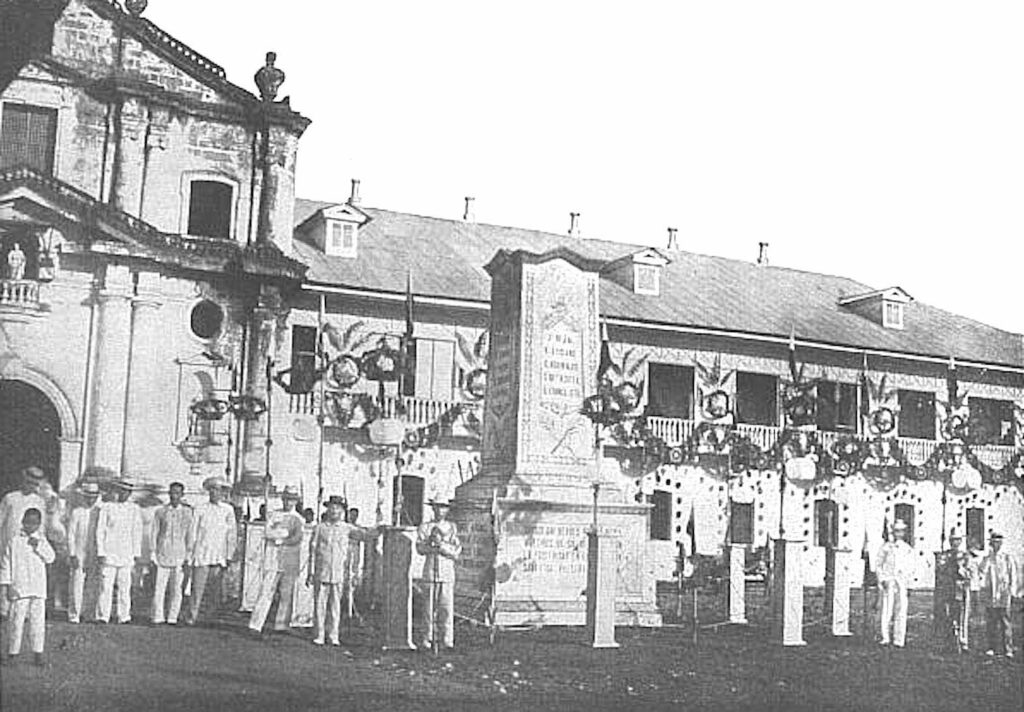September 1898: Political spotlight switches from Bacoor to Malolos

Barasoain Church, Malolos, Bulacan: Following the ratification, there were large celebrations in Malolos on September 29 and 30. The crowd size was estimated at 25,000 to 30,000 celebrants.
At the beginning of September 1898, the armistice for the Spanish-American War in the Philippines was holding. The number of American soldiers arriving in the Philippines was increasing steadily. There was tension between the American troops and Aguinaldo’s forces, but direct confrontation was minimal. Many of the American soldiers were able to go sightseeing in Manila and along Manila Bay.
There was optimism among the American volunteer soldiers that they were heading home soon. They had only arrived in the Philippines in late June and throughout the month of July, 1898. The rumors circulating in Manila said that they would leave the Philippines by the end of September. The enlisted volunteers had only signed up for the Spanish-American War, and the only part of the war not finished was the final peace treaty.
Several members of the 10th Pennsylvania Volunteers were sent back to Cavite to retrieve their supplies and equipment from their old camp site called Camp Dewey. Most of the 10th Pennsylvania Volunteers were assigned guard duty at the jails in Manila and the penitentiary. Many of the inmates at the prisons and jails were political prisoners. The Filipino political prisoners, who had suffered under Spanish misrule, were released over time by the Americans.
You may like: The staged ‘Battle of Manila,’ August 13, 1898
There was one confrontation between the 10th Pennsylvania Volunteers and Aguinaldo’s forces. Approximately 300 rebels surrounded the back of one of the prisons and demanded the immediate release of political prisoners. A member of the 10th sounded a bugle call, and the reserve troops of the 10th ran to the prison to reinforce their fellow soldiers. The rebels were complaining that the political prisoners were not being released fast enough. The issue was resolved without bloodshed.
September was a very busy month for President Emilio Aguinaldo. He decided to transfer the Philippine seat of government from Bacoor in Cavite Province to Malolos in Bulacan Province. Malolos was located about 30 miles north of Manila and was selected because of its extensive transportation lines. The city could be reached on land by train and roadways. There were also waterways leading to Malolos, which could provide boat access to and from Manila Bay.
President Aguinaldo departed Bacoor on September 9, 1898. When Aguinaldo arrived at Catmon train station in Malolos on September 10, 1898, the reception was very warm and enthusiastic. There were many bands from several provinces at the train station. Members of Aguinaldo’s administration also arrived with him at the Catmon station.
On September 15, 1898, the Revolutionary Congress, also known as the Malolos Congress or Filipino Congress, had convened its first governmental session. Initially, there were eight-five Congressmen. Eventually, the amount of Congressmen increased to one hundred and ten. Most of the Congressmen were very well educated and successful. Pedro Paterno was officially the President of the Congress. The sessions were held at the Barasoain Church in Malolos. President Aguinaldo addressed the inaugural session of the Congress at the church.
The Malolos Congress debated and agreed on sending diplomats to other countries. There was an urgent need to obtain formal recognition of Philippine Independence from other countries. Unfortunately, the United States during the Paris treaty discussions did not recognize Philippine Independence. The U.S. argued at the Paris conference that if it did not annex the Philippines another imperial power would seize it.
On September 17, 1898, the Congress established committees to carry out the essential and normal functions of government such as appropriations and internal regulations. One of the committee was tasked with drafting a Constitution for the country.
On September 29, 1898, the Congress approved the ratification of Philippine Independence, which had originally been proclaimed by Emilio Aguinaldo on June 12, 1898 at Kawit, Cavite. Following the ratification, there were large celebrations in Malolos on September 29 and 30. The crowd size was estimated at 25,000 to 30,000 celebrants.
In the crowd at Malolos on September 29 and 30 were American officials and military officers. Two enlisted men from the 10th Pennsylvania Volunteers were also present at the celebration.
When the two enlisted members of the 10th returned to their barracks in Manila, they told their comrades in arms that they had a “good time” and compared the town of Malolos to Pittsburgh, Pennsylvania. The two enlisted men admitted to their fellow soldiers that they were initially very skeptical of Filipinos and Philippine Independence. However, after they saw the large, fun-filled and organized ceremonies in Malolos, they said that the Filipinos could take care of themselves.
Dennis Edward Flake is the author of three books on Philippine-American history. He is a public historian and former seasonal park ranger in interpretation for the National Park Service at the Eisenhower National Historic Site in Gettysburg, PA. He can be contacted at: flakedennis@gmail.com

